Opponent process theory and colour constancy
1/34
There's no tags or description
Looks like no tags are added yet.
Name | Mastery | Learn | Test | Matching | Spaced |
|---|
No study sessions yet.
35 Terms
Opponent theory
proposed that colour vision is caused by opposing responses generated by blue/yellow, green/red, and black/white
in this theory the primary colours are red, blue, yellow and green
Hering proposed this
Opponency
pairs of colours have opposite responses (pairs)
they cant be seen at the same time
Behavioural evidence of opponent theory
After images
Simultaneous colour contrast
Types of colour blindness according to opponent theory
red/green and blue/yellow
Why does green create a red after image?
trichomatic theory cant explain this
Physiological evidence of opponent theory
opponent neurons
Opponent neurons
neurons with excitatory response to light from one part of the spectrum, and inhibitory response to light from another
Where are opponent neurons located?
In the retinal ganglion cells and LGN (lateral geniculate nucleus).
What is M+, M- ?
M+ means medium wavelengths activate it
M- means medium wavelegths inhibit it
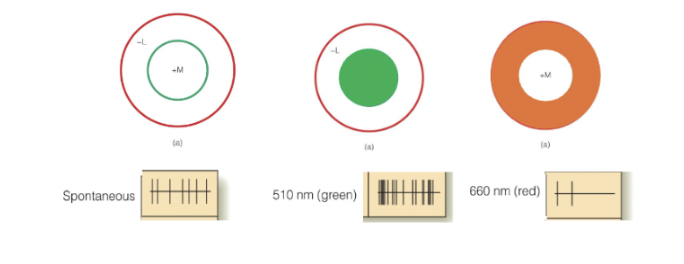
Different shapes of opponent neurons
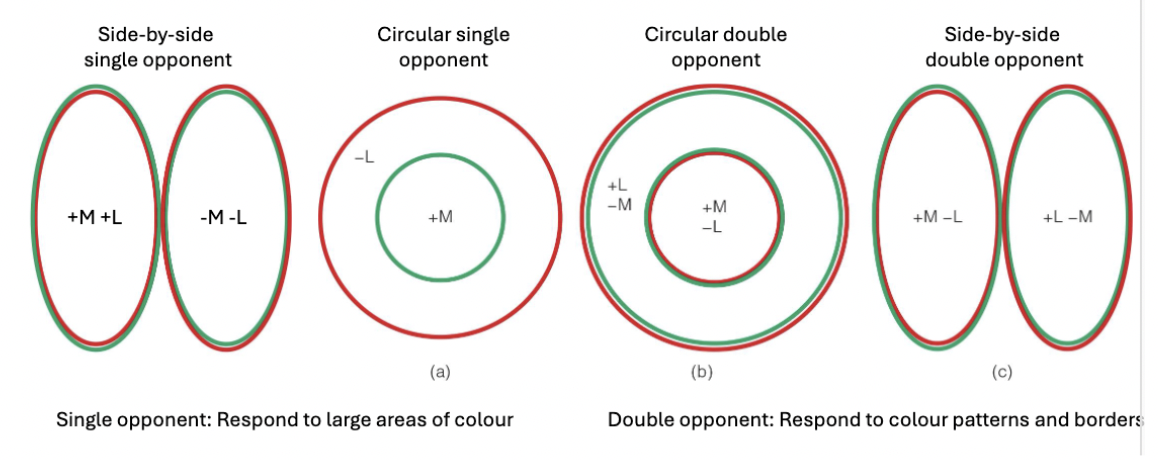
double opponent neurons are good at undersanding transitions from one colour to another
+S –ML Cell – Function
The +S –ML cell receives an excitatory input from the S cone (short wavelength) and an inhibitory input from cell A, which sums the inputs from the M and L cones (medium and long wavelengths).
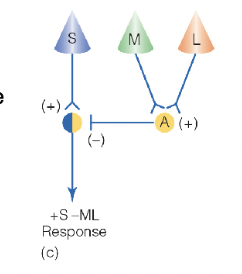
creates the +B-Y cell
when both M and L receptors are stimulated we see_____
yellow
+ML –S Cell
circuit that sums inputs from the M and L cones and compares them to the S cone, creating the +Y –B cell.
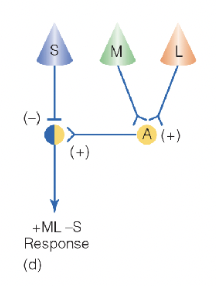
Unique Hues
Unique hues are primary color experiences that are built from four primary colors: red, green, blue, and yellow.
Why is the idea of unique hues more complex than simple opponent neuron firing?
It’s not as simple as +M – L = +G – R because the three cones are not spaced evenly across the spectrum. There’s significant overlap between the M (medium) and L (long) cones, making the system more complicated.
What do opponent neurons indicate?
Opponent neurons indicate the difference in responding between pairs of cells, with one cell being excitatory and the other inhibitory, depending on the wavelength of light.
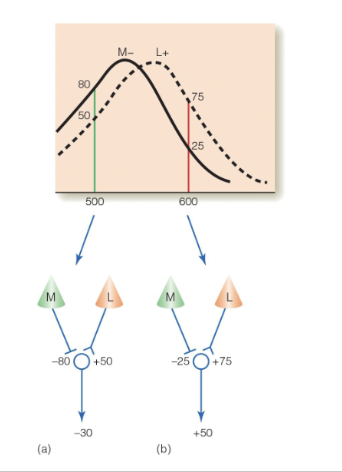
If we presented 500nm light, the +L –M cell would show activation from the L cone (long wavelength) and inhibition from the M cone (medium wavelength), and if we presented 600nm light, the difference in activation between the two cones would change, altering the response and perceived color.
Which theory is true opponent or trichromatic theory?
Probably they are both true and combined sometimes.
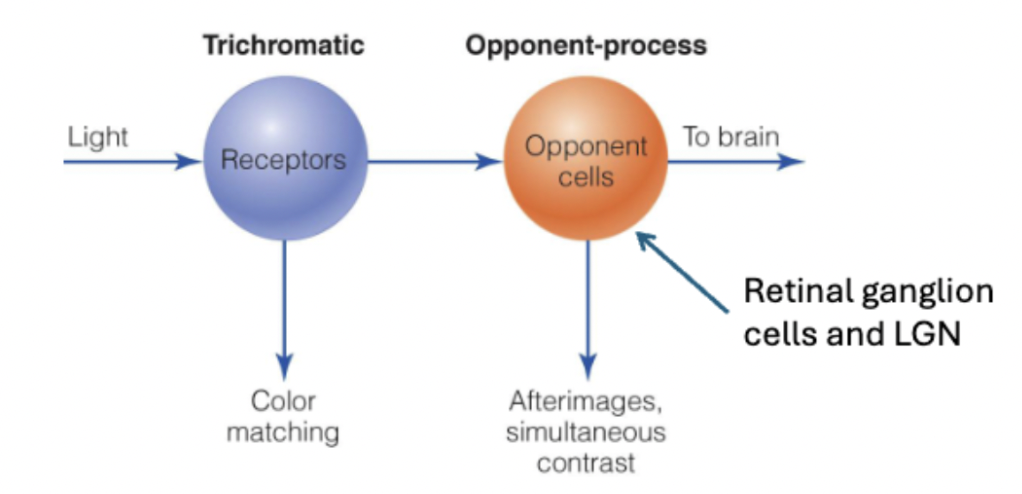
What region of cortex is specialized for colour perception?
There is no single module for color perception. Cortical cells in V1, V2, and V4 contribute to color processing by responding to specific wavelengths or having opponent responses, and they also play a role in processing forms and orientations.
Colour constancy
perception of colour is relatively constant despite changing light sources
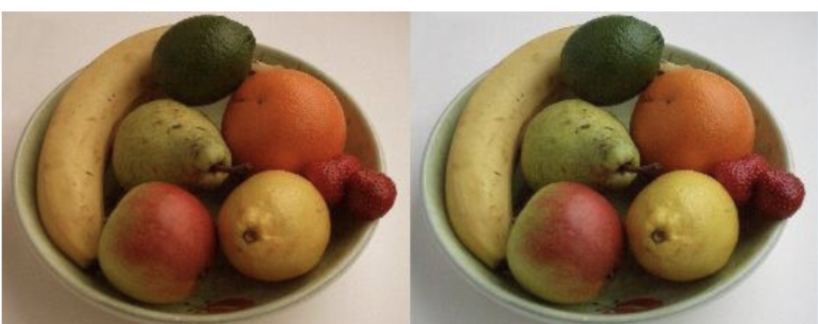
pear is green in both even though it looks differrnce cause of the light
How does the color of a green sweater change under different lighting conditions?
Under sunlight (bright white light), the green sweater reflects a balanced spectrum of wavelengths. Under incandescent light (warm light), more long wavelengths are reflected, making the sweater appear warmer. Under LED lights (which have a higher representation of cooler, short wavelengths), the sweater looks cooler, with more short wavelengths being reflected.

Chromatic adaptation
prolonged exposure to chromatic colour leads receptors to adapt to that colour
adaptation to light source could lead to coloru constancy
ex) when u first put on pink sunglasses, you lose colour, but over time the you adapt and the pink turns off and we start to see colours in a constant maner.
What are some contributions to colour constancy/
chromatic adaptation
effect of surroundings
Memory and colour
Why do some people see THE DRESS as black and blue while others see it as white and gold?
One explanation is color constancy, which involves differences in how people interpret illumination. If the dress is seen as being lit by cool light, the brain discounts blue wavelengths, leading to a perception of white and gold. If it's seen as lit by warm light, the brain discounts yellow wavelengths, leading to a perception of black and blue. This is an example of a corrective mechanism like white balance correction.
Opponent cells
information from cones converge onto ganglion cells (which we know already)
there are ganglion cells that specifically receive info and respond to the presence of opponent cells
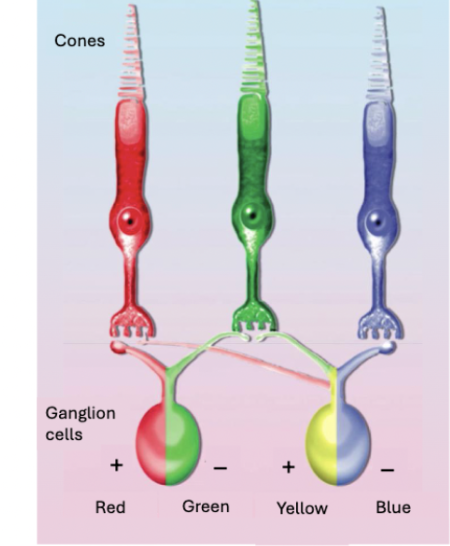
How many types of opponent cells are there?
There are 4 types of colour opponent cells
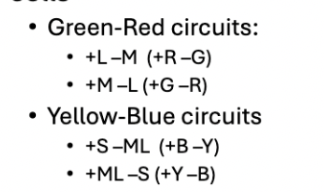
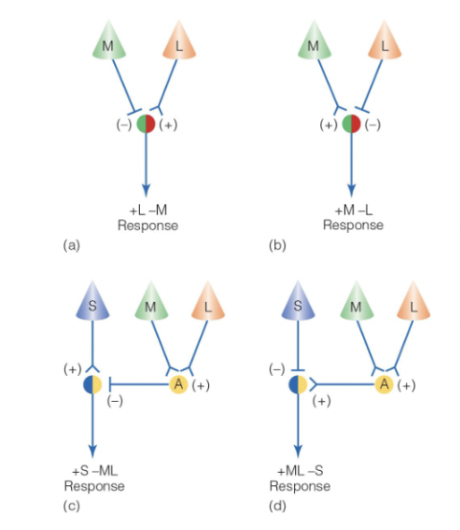
Lightness constancy
perception of whites, greys, and blacks is relatively constant despite changing light sources

Dog is still black even though there is more light reflecting
Ratio prinicple in lightness constancy
two areas that reflect different amounts of light look the same if the ratios of their intensities are the same
ex) in a dimmer room, a light square will reflect more than black square - but the relative amount of what's being reflected by black and white is the same. So we end up having the same proportional differences between them.
The problem of uneven illumination
ratio principle doesnt work in uneven illumination
perceptual system must distinguish between reflectance edges and illumination edges.
Reflectance edges
edges where the amount of light reflected changes between two surfaces.
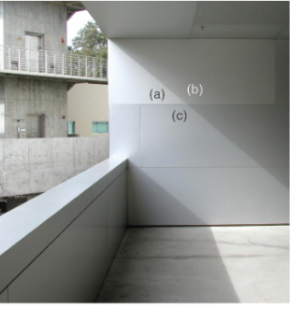
a&c
illumination edges
edges where lighting of two surfaces changes

a&b
How can we solve the problem on uneven illumination?
By recognizing shadows
Penumbra
fuzzy edge of shadow
when we see penumbra its clear its a shadow, whearas when we see an outline it likely isn’t a shadow.
Mantis shrimp
Mantis shrimp have more cones and have sensitivity to UV and infrared light.
Their ability to perceive colour is unimaginable.
Do wavelegths show colours?
Wavelengths themselves don't "show" colors, but they are the physical property that determines what color we perceive, how we percieve that colour is dependent on how our brain interprets the wavelength.